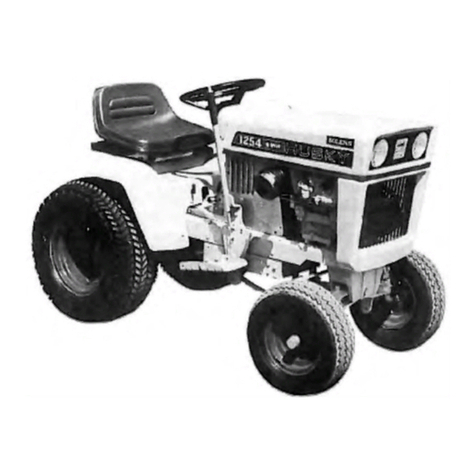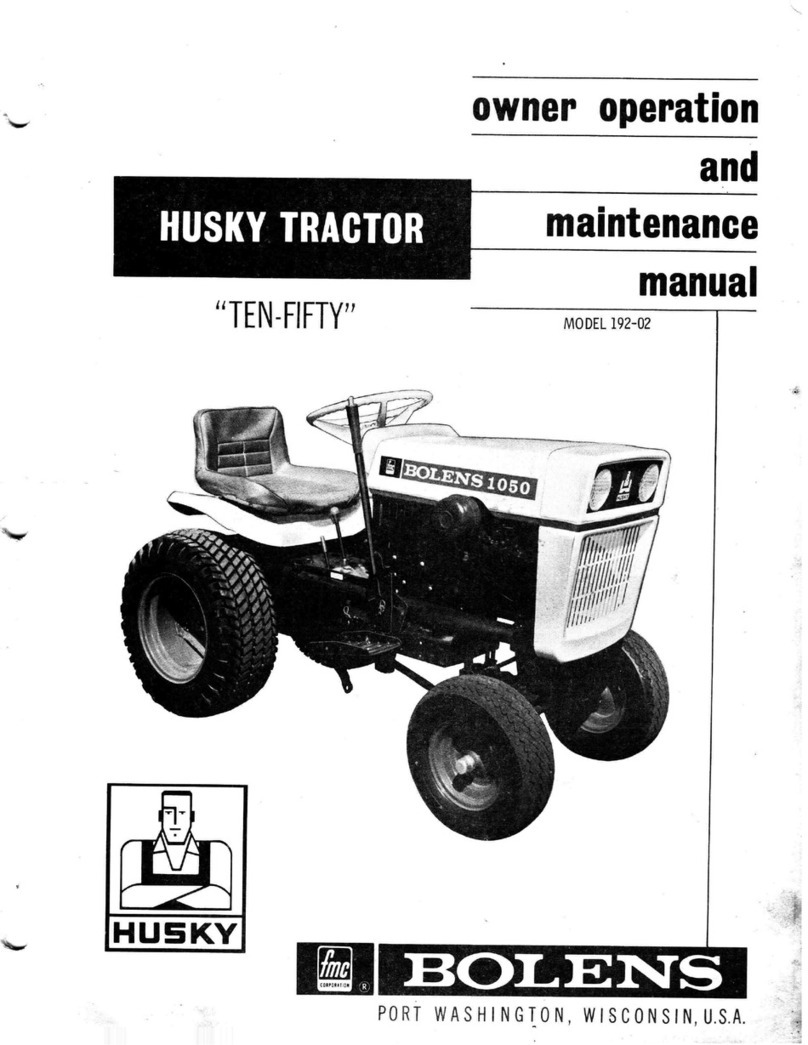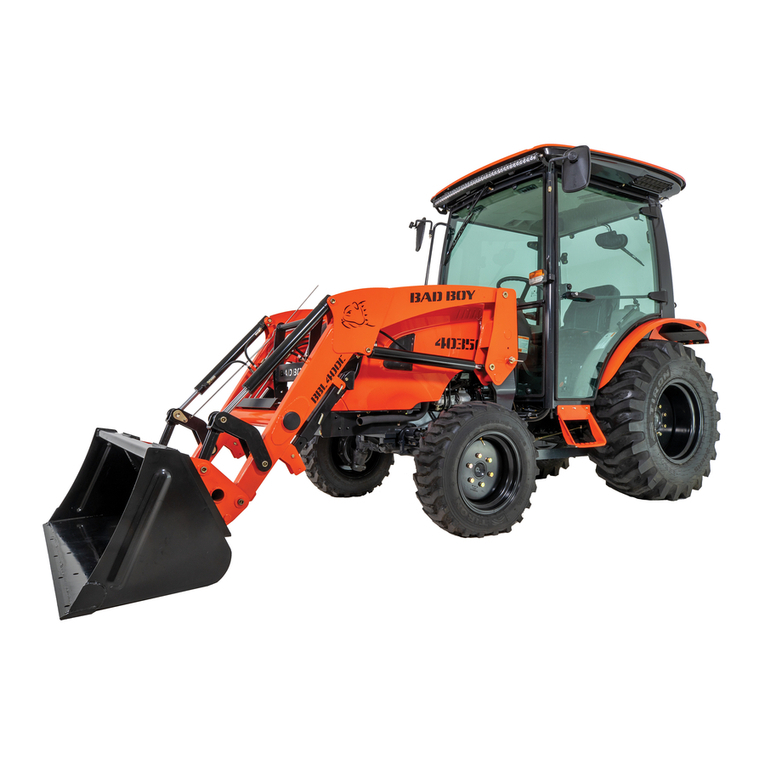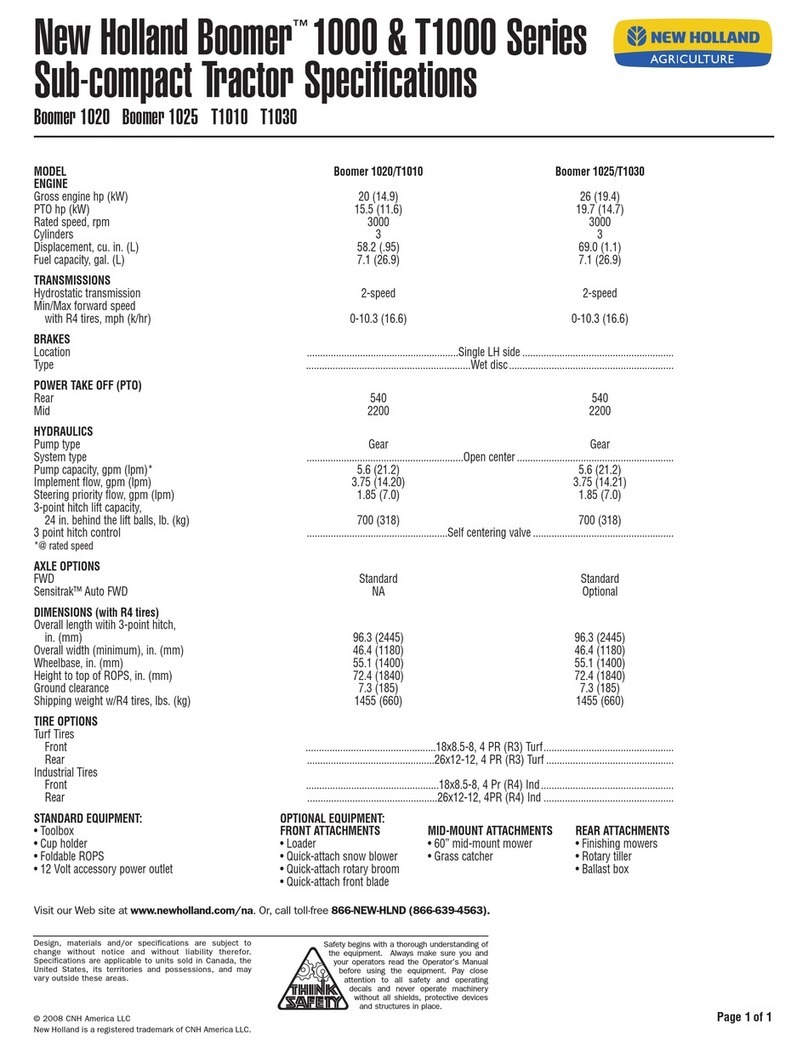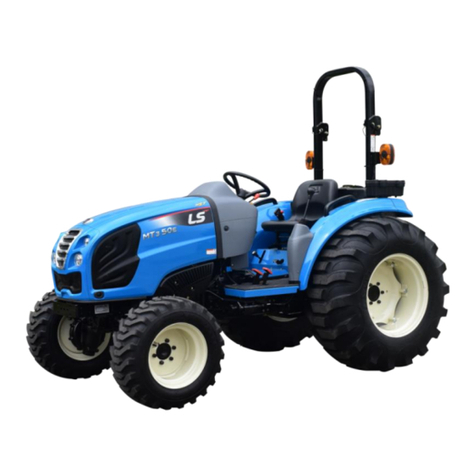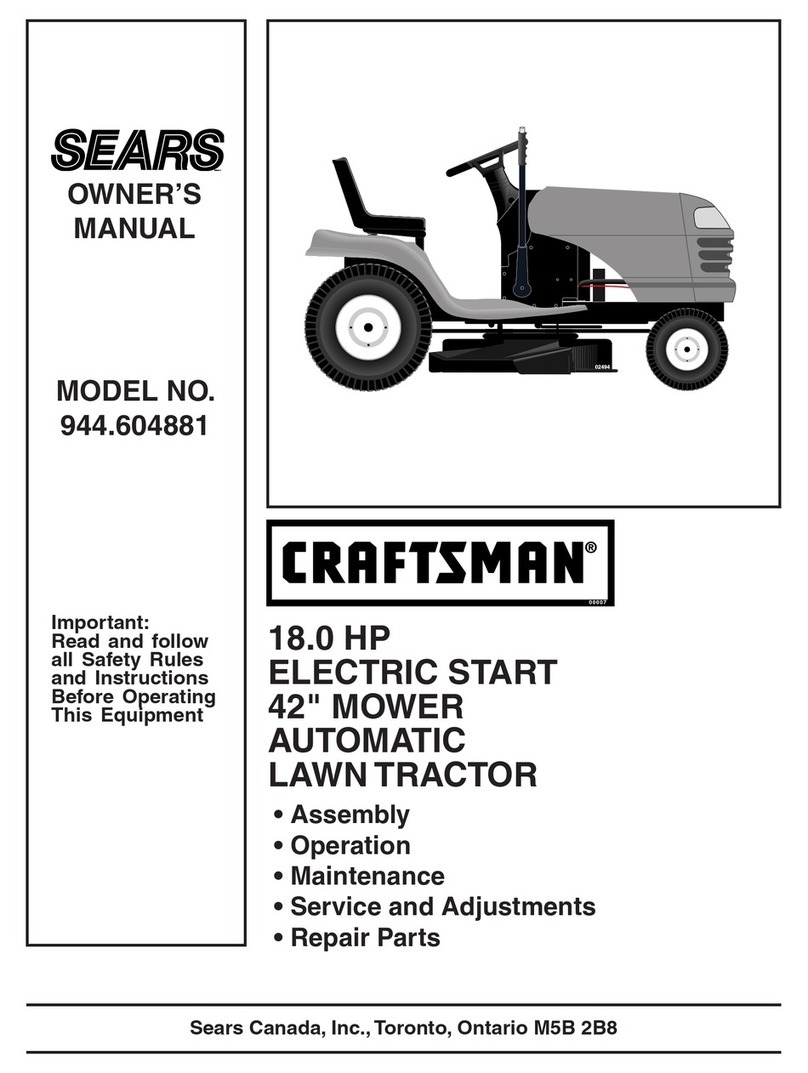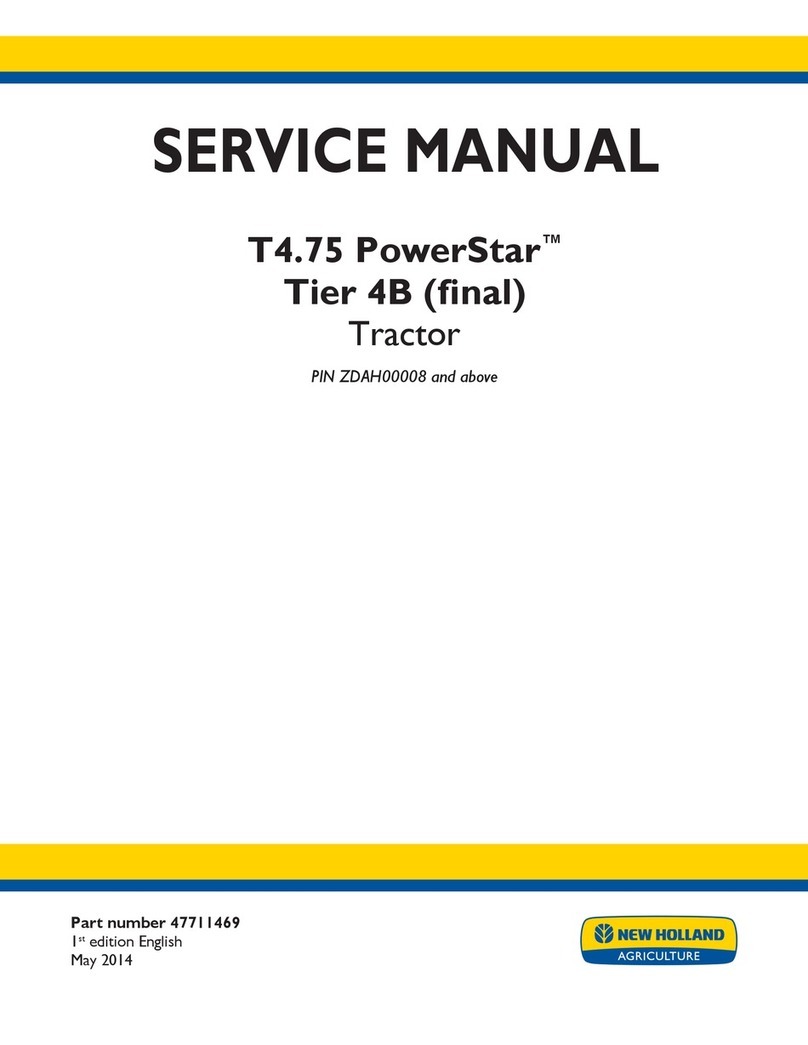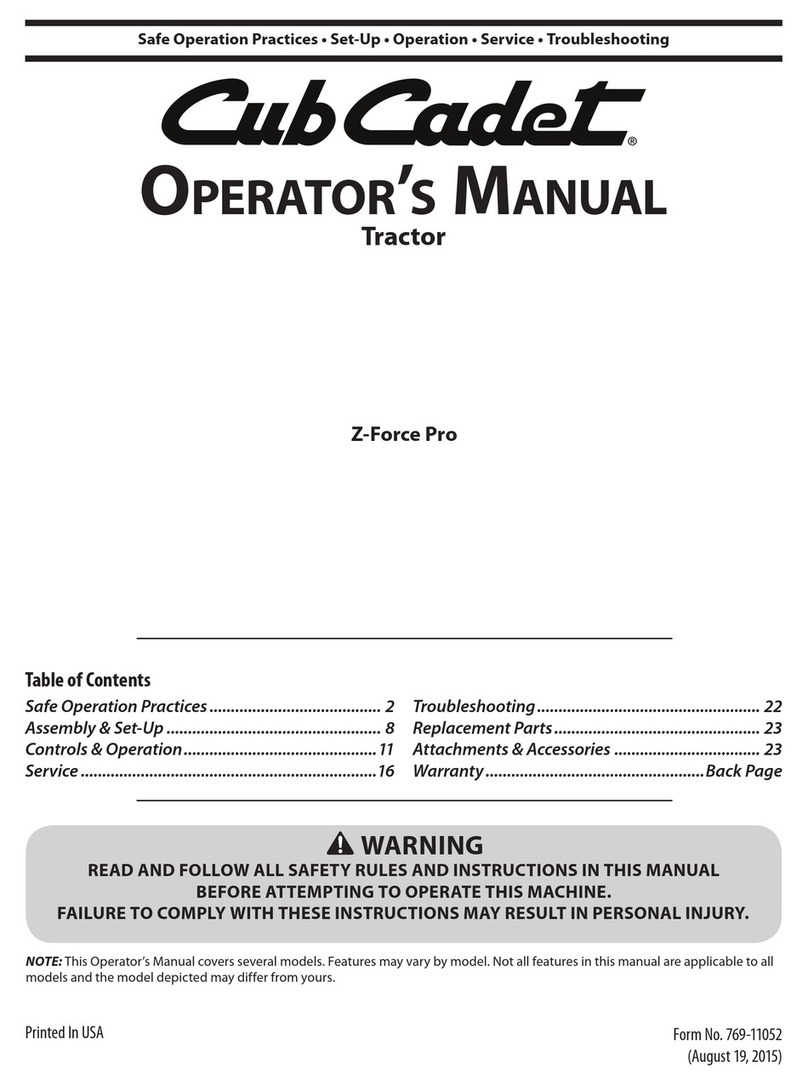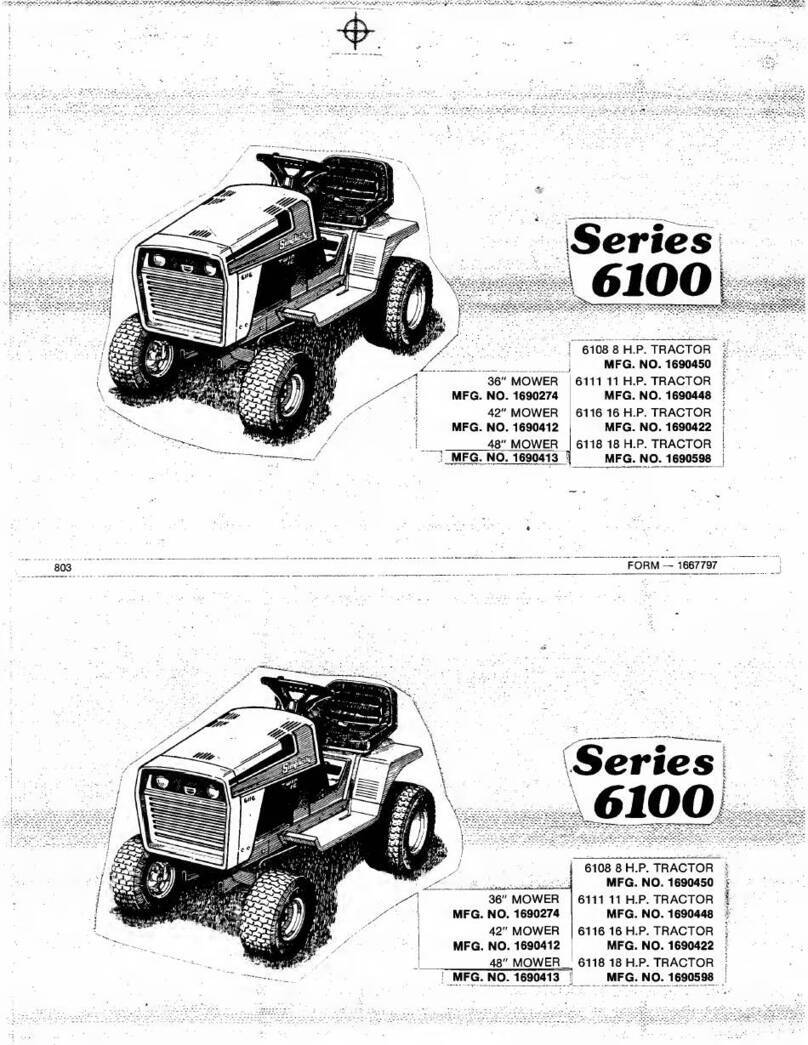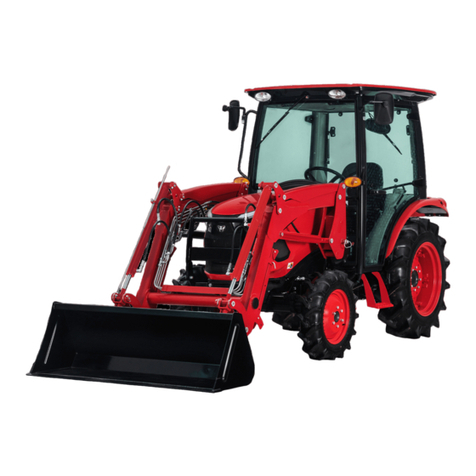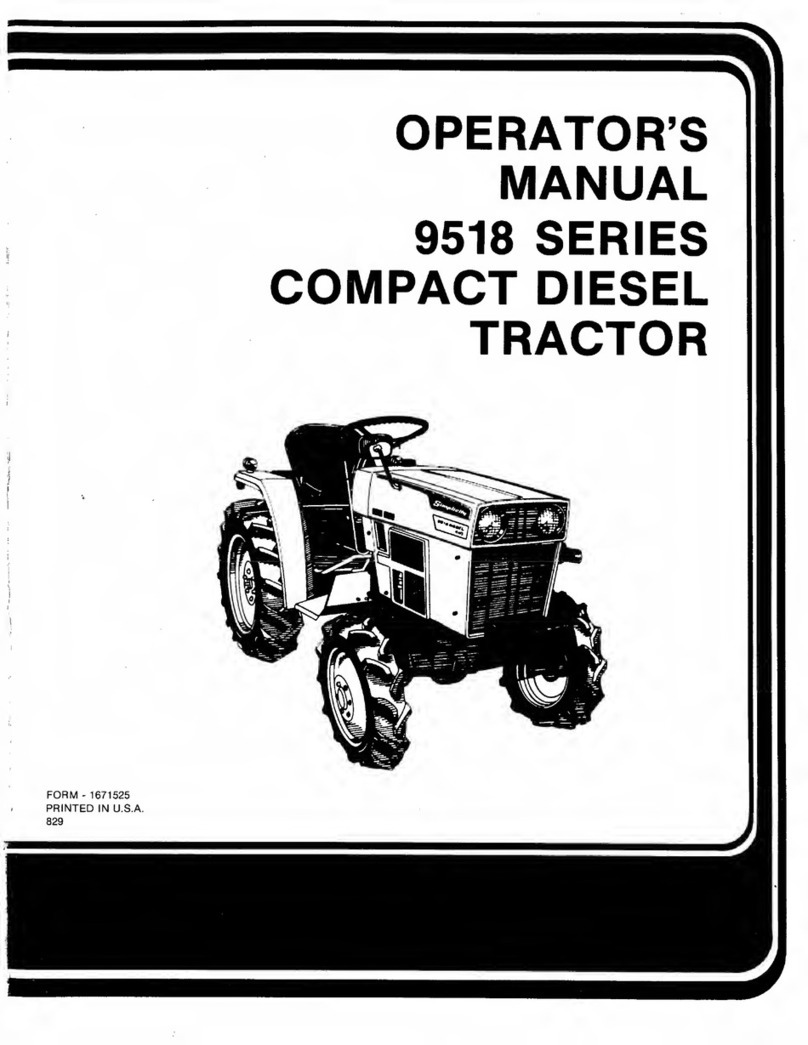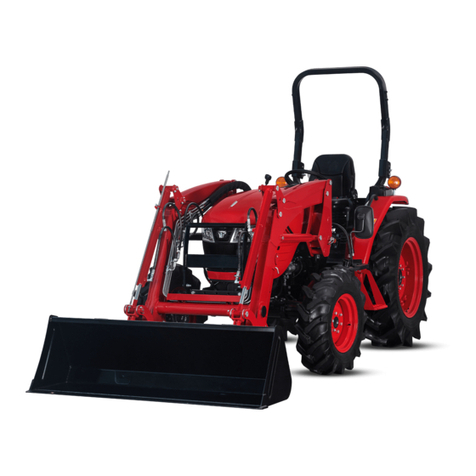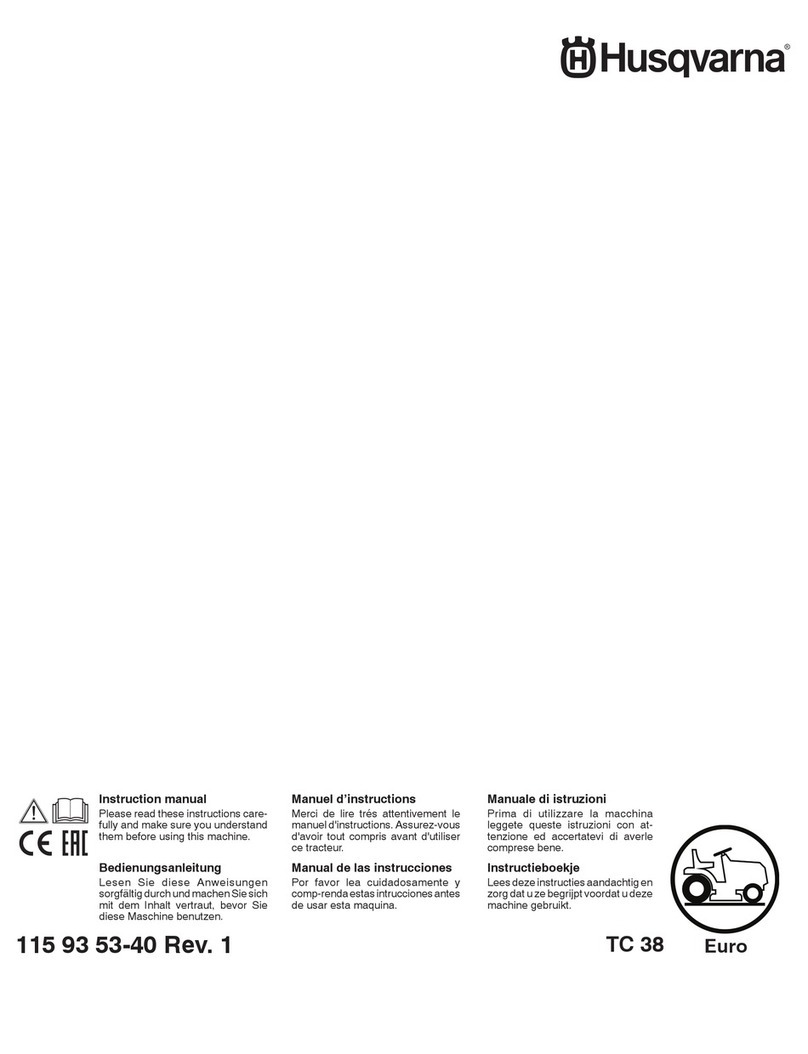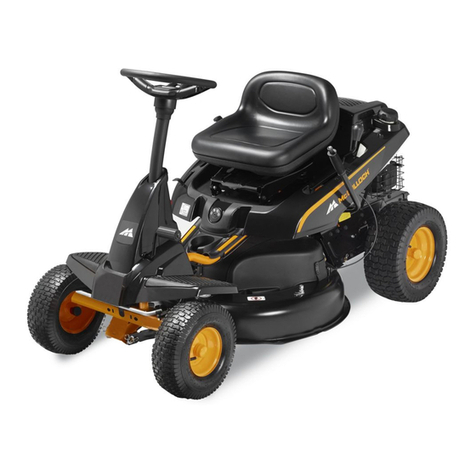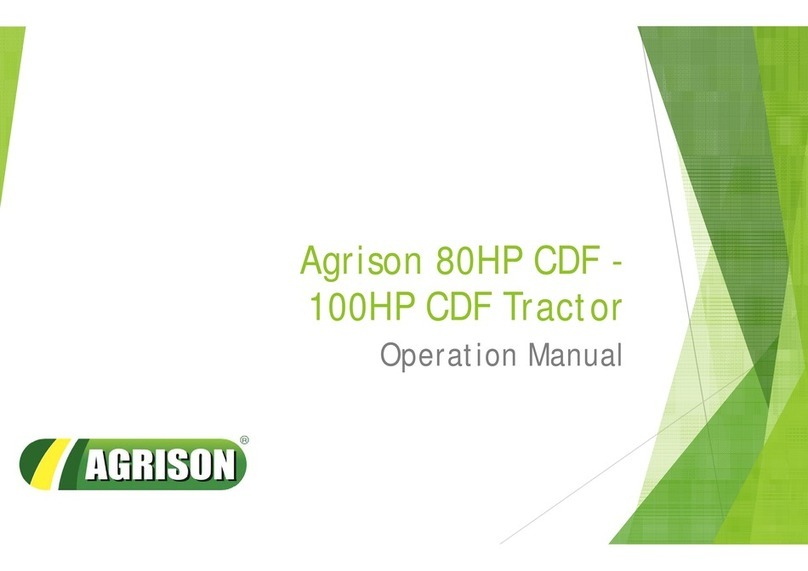Husky BOLENS 194-01 Installation guide

"TWElVE-
TWENTY
FIVE"
HUSKY
owner
operation
and
maintenance
manual
MODEL
194-01
OLENS
PORT
WASHINGTON,
WISCONSIN,U.S.A
.


GENERAL
SAFETY
PRECAUnONS
Preventing
accidents
is
the
respon~ibllity
of
every
equipment
operator.
The following
generalsafetypre-
cautions
must
be fully
understood
and followed
by
every
operato
r
of
this
tractor
and
its
attachments
.
Re-
view
them
frequently andNEVERTAKECHANCES. BE
CAREFUL BEFORE,
DURING
AND RIGHT
AFTER
USE
OF
ANY
POWERED EQUIPMENT. ACCIDENTS
CAN
BE PREVENTED.
1. Mount
vehicle,
place
travel
pedalinNEUTRAL,and
place
transmission
lever
in
park
prior
to
starting
en-
gine,
to
prevent
unit
from
being
started
in
gear.
2. Do not mount
or
leave
vehicle
while it
is
in motion
or
in
actual
operation,
nor
leave
vehicle unattended
while engine
is
running.
Injury
to
the
operator
or
a
tractor
runaway could
occur.
3. Always
shut
ofi
engine,
place
travel
pedal in NEU-
TRAL, and
place
transmission
in
park
whenever
vehi-
cle
is
to be left una
tten
ded. Lower
all
attacttments
to
the ground with
P.T.O.
lever
in
OFF
position when
leaving the unit unattendedto
prevent
injury
to
children
or
other
persons.
4. Attachments
must
be lowered
to
the
ground
when
storing
tract
or
to
prevent
the
attachment
from
being
dropped accidentally and
causing
injury.
5. Do not tow
vehicle.
Damage to
the
vehicle could
occur.
6. When moving
the
vehicle,
place
travel
pedal in
NEUTRAL. Damage to
the
transmission
could
occur.
7,
Do not
carry
passengers.
Thepassengerscouldfall
off vehicle
receiving
injuries.
8.
Do
not
start
or
operate
vehicle in an Inside
area,
unless
it
is
well
ventilated. Exhaust
gases
carry
carbonmonoxide
fumes
which
are
poisonous.
They
can
~ause
serious
illness
with
side
affects
or
death.
9. Keep
tractor
and
attachments
free
of
excess
grease
and
oil.
The
un
it
will
operate
cooler,
be
easier
to
maintain and
safer
to
operate.
10. Engine
must
be stopped, and
P.T.O.
disengaged
when cleaning,
servicing,
adjusting,
repairing,
or
in-
stalling
attachments
on
tractor.
This
is
necessary
to
avoid
possible
injury
from
moving
parts.
11. Always disconnect ground
(-)battery
cable
from
battery
before
doing any work on the
electrical
sys-
tem,
and
reconnect
last.
Indoing
this
youwill avoid
yie
possibility
of a
short.
12. Study
your
manual. Know
your
tractor
before
operating
it.
Take
time
to
operate
the
unlt
in the
safest
manner.
13. Always follow
manufacturer's
operational
sugges-
tions.
14.
Do
not allow
children
to
operate
vehicle
at
any
time.
The
average
child
is
not mentally capable of
coping with the
intricacies
of
operating
a power
tool.
15. Do not allow
adults
to
operate
vehicle
without
proper
instruction
including
all
safety
Instructions.
In
doing
so
you
will
be
sure
theyknowhow to
operate
unit
properly
and
also
are
aware
of
all
the
safety
precau-
tio
ns.
16. Do not fill
gasoline
tank when engine
is
running
or
hot. Add
gas
only
outdoors,
with a funnel and when
en-
gine
ls
cool.
KEEP
SMOKERS
AWAY
FROM UNIT
WHILE FUELING. THISWILLHELPELIMINATETHE
POSSiBILITY
OF
FIRE
AND
EXPLOSION FROM
SPILLED GASOLINE OR FUMES.
17.
Store
fuel in
approved
container
out
of
reach
of
children.
Gasoline
is
highly flammable and the
fumes
highly explosive.
18.
Never
operate
tractor
with
mower,
snow
caster
or
any
other
attachment
having moving
parts
when any
chlld
or
person
is
in
travel
path
or
discharge
area.
Children
must
not be allowed in
or
near
working
areas
when equipment
is
being
used.
Items
or
objects
such
as
wire,
stones,
small
toys and e
tc.
can
be
ejected
at
high velocity out
of
the
discharge
chute.
19. Study
all
attachment
manuals thoroughly
before
using
attachments
with
tractor.
In
so
doing you will
then
be
aware
of
boththe
tractor's
andthe
attachment's
capabilities
when
usedasaunlt,alsothesafes
t
manner
in
which to
operate
them.
ENGINE CAUTIONS
1. Check
oil
level
at
regular
intervals
at
least
after
every
8
hours
of
operation
, (see Engine Manual
for
proper
level)
oftener
under
severe
operating
condi-
tions. Before removing plug
for
checking
clean
the
area
aroun
d the plug thoroughly or
all
dirt
and
debris.
Th
is
material
could
accidentally
drop
into
the
crank-
case
and contaminate it
causing
damage
to
theengine.
2.
Change engine
crankcase
oU
at
intervals
specified
in engine manual,
oftener
under
severe
operating
con-
dltions.
This
will help
assure
proper
lubr
icati
on
to
the
internal
parts
of
the
engine and
also
keep the
level
of
oil
contamination low.
3.
Before
starting
the engine, check and
clean
engine
flywheel
screen
and cooling fins of
dirt
and
debris.
It
is
good
practice
to
also
check
and
clean
the
screen
frequently during the
operation
under
severe
dirt
con-
ditions.
Grass
particles
andforeign
debris
are
inclined
to
build up
in
the engine cooling
channels.
At frequent

intervals
tne
cooling
shroud
should
be
removed
and
the
cooling
fins
and
screen
thoroughly
cleaned
of
all
dirt,
debris
and
oily
film,
to
preve11t
overheating
and
/
or
engine
damage.
DO NOT AT
ANY
TIME
OP~RATE
ENGINE WITH COOLING SHROUD REMOVED1\S THIS
WOULD
PREVENT
PROPER
COOLING
OF
ENGINE.
5. When
stopping
engine,
especially
after
lt
has
been
working
hard,
let
the
engine
idle
for
approximately
3
to
5
minutes.
This
will
allow
engine
to
cool
down
more
rapidly
preventing
ove
rheating
and/or
damage
to
the
engine
.
4.
Check
air
cleaner
for
di
rt
and
debris
regularly,
daily
under
severe
operating
conditions,
and
clean.
When
reinstalling
be
sure
that
it
is
securely
positioned
to
prevent
any
leaking
of
air.
See
Engine
Manual
for
proper
pl'OCedure
and
interval.
A
dirty
air
cleaner
could
allow
dirt
and
g1·H
to
enter
the
engtne
through
the
air
intake
cilusing
wear.
Also
a
dirty
air
cleaner
c
an
cauM
damage
to
the
engine.
6.
Do
n
ot
race
or
gun
engine
to
hurry
warm-up
after
starting,
but
idle
it
a few
minutes,
tbls
will
give
the
oil
a
chance
to
circ
ulate
thro
ugh
the
engine.
7. On
units
witha
gasoline
strainer,
the
strainer
should
be
in
spected
frequently.
If
water
is
present
in
the
bottom
of
the
tank,
remove
the
fuel
line
and
drain
until
droplets
of
water
are
gone.
If
dirt
ls
noticed
at
bottom
of
the
tank
remove
the
tank
and
clean
it
tllor-
oughly.
TO
THE
OWNER
This
is
an
operational
and
general
maintenance
ma
n
ual
only
and
does
not
cover
major
repair
.
AU
major
repair
work
must
be
performed
by an
authorized
DO
LENS
DEALER
or
the
factory
warranty
is
void.
Dolens
equipment
is
ca1·efully
engineered
to
give
good
performance
if
properly
operated
and
maintained.
Keep
your
equipment
clean
and
lubricate
it
as
prescribed
in
this
manual.
Periodically
inspect
your
unit
and
per-
fol·m
any
upkeep
maintenance
necessary.
Your
dealer
is
obligated
by
the
facto,.ry
to
completely
assemble
and
service
new
equipment
prior
to
first
delivery,
and
thorough
ly
exp
lai
n
and
demonstrate
its
opera-
tion.
He
will
repair
or
replace
anypartswhich
fail
due
to
defective
ma
t
er
i
al
and
/
or
workmanship
during
the
warranty
period,
and
also
provide
future
repair
service
and
supply
genu
ine
facto~;y
repair
parts.
IN
EVENT
OF
ANY
PROBLEM
OR PARTS REQUIRED ALWAYS CONTACT YOUR
DEALER.
DO NOT RETURN PARTS
TO
THE
FACTORY.
WE
REQUIRE PRIOR
FACTORY
APPROVAL
ON RETURt'IS,
AND
APPROVALS
ARE
ISSUED ONLY
TO
BOLENS DEALERS OR DJSTRIJlUTORS.
READ YOUR WARRANTY (YELLOW) STATEMENT AND
BE
SURE
TO
MAI
L
THE
POSTPArD WARRANTY
REGISTRATIO~
(WHIT.
E)
CARD
TO
THE
FACTORY,
TABLE
OF CONTENTS
General
Safety
Precautions
.
Engine
Cautions
.
Serial
Number
Specif
ications
. .
Controls
.
••••
Pre-Operational
Checks
81·eak-in
Period
•
Starting
the
Engine
•..
Stopping
the
Engine
. • •
Operation
.•...•••
Preventive
Maintenance.
Adjustments
• • . . • • .
Power
Take-Of£
(P
.
T.
0. )
Maintenance
Guide
Lubrication
•.••
Lubrication
Chart
• •
Wiring
Diagram
• •
Storing
Your Husky
Tractor
Minor
Trouble
Shooting Guide
Page
Inside
Front
Co\·cr
I
nside
Front
Covet·
2
3
3
4
4
5
5
5
7
8
11
12
12
13
14
{4
15
1

LIGHT SWITCH
IGNITION
KEY/STARTER
SWITCH
BATTERY
UNDER HOOD
ENGINE
PTO {POWER
TAKE-OFF)
PTO
CL.UTCH
FOR
ATTACHMENTS
IMPLEMENT
HITCH
Figure
1
SERIAL
NUMBER
To
ensure
prompt
service
when
repairs
or
adjustments
are
required,
your
Bolens
Dealer
must
have
the
follow-
ing
information.
For
your
own
personal
reference.
fill
in
the
spaces
provided below,
1. Model
number
of
Tractor.
_________
_
2.
Serial
number
of
Tractor.
____
_____
_
3. Model
number
of engine.
_________
_
4.
Serial
and Spec.
Number
of
engine.------
Figure
2
2
Your
Bolens
dealer
has
a
master
Parts
List
for
your
unit. He
can
identify any
parts
you may
require
and
furnish
genuine factory
replacements.
When
ordering
engine component
parts,
consult the
Engine Manufacturer•s Manual,
or
with
an
authorized
representative
of
the
Engine
Manufacturer.
Flgure
3

SPECIFICATIONS
Wisconsin
electric
start-
Engine i.ng, 12
HP
at
3600
RPM
Type
4
cycle,
single
cylinder,
air
cooled
Fuel
capacity
5
quarts
Oil
capacity
1
quart
Air
cleaner
Heavy
duty
dry
type
(see
Engine
Manual)
Drive
Hydrostatic
transmission
Speed
Infinitely
variable.
Forward
approx.
8
mph.
Reverse
approx.
4 mph.
Power
to
Farm
tractor
type
(PTO)
direct
attachments
drive
with
universal
joints
and
splined
shaft.
Tires
Extra-wide
terra-tires.
Front:
16
x 6.
50-8.
Rear:
23 x
8.
50-12.
With
lawn
and
garden
tread.
Height
40
inches
Width 34
inches
Length
63
inches
Wheelbase
43
inches
Turning
radius
40
inches
Ground
clearance
7
inches
Shipping weight 615 pounds
Standard
PTO
assembly,
hydrostatic
equipment
drive,
fenders
and
seat
cus
hion,
hydraulic
lift
cylinder.
Location
of
On
tractor
frame
left
hand
side
tractor
model
and
next
to
foot
rest.
serial
number
Location
of
Wisconsin
Engine,
front
engine
engine
model
and
shroud.
serial
number
CONTROLS
For
efficient
operation
ofthe
tractor,
study
the
accom-
panying
illustrations
(see
Figure
4),
together
with
the
brief
descriptions
given
here,
until
you
are
thoroughly
familiar
with
the
location
and
function
of
each
control.
----
------
Figure
4
1.
Transmission
Lever.
Place
transmission
selector
lever
in
•••
••..
DRIVE
for
infinitely
\'ariable
speeds
from
approx·
imateiy
0-8
mph
forward
to
0-4
mph
in
reverse
.•
.•
PARK
for
starting
and
when
tractor
is
at
rest
.
DO NOT
PLACE
TRANSMISSION
LEVER
INTO
PARK POSITION WHILE TRACTOR IS IN
MOTION. PREMATURESHIFTINGINTOPARK
MAY
RESULT IN SERIOUS DAMAGE
TO
THE
HYDROSTATIC TRANSMISSION.
2. POWER TAKE
OFF
CLUTCH (PTO) -Always
be
sure
to lock
lever
in
slots
provided
when
P.T.O.
is
engaged
or
disengaged.
3.
THROTTLE.
Pull
t
hro
ttle
knob
outone-halfwayfor
starting.
More
or
less
throttle
may
be
required
due
to
grade
of
fuel
and
tempera
ture
variations.
A
llow
engine
to
warm
up,
then
adjust
thro
ttle
to
full engine RPM
while
operating
under
load.
NOTE
OPERATE
TRACTOR AT
FULL
THROTTLE
AT
ALL
TIMES.
4.
TRAVEL
PEDAL,
Depress
toe
end
of
pedalfor
for-
ward
motion and
depress
heel
endofpedalfor
reverse
motion.
Provides
instant
braking
and
speed
regulation.
(See
Figure
4.)
3

Figure
5
IMPORTANT
SEE HYDROSTATIC DRIVE
PAGE
6.
5.
CHOKE -
When
st
arting
engine,
pull
knob
out
to
close
the
choke,
pushing
knob
gradually
in
as
en
g
ine
warms
up. A
warm
engine
requires
less
choke when
starting.
6. IGNITION KEY
-STARTING
SWITCH •
Turn
ignition
key
to
the
right
to
start
engine.
Release
when
engine
starts.
DO
N
OT
HOLD KEY IN START POSITION
FOR
MORE THAN 30 SECONDS
AT
ONE
TIME.
ALLOW TWO MINUTES
BETWEEN
STARTING
ATTEMPTS.
7. LIGHT SWITCH -
Pull
knob
out
to
turn
lights
on,
push
in
to
turn
them
off
.
8.
AMMETER -
Indicates
amount
or
charge
an~
amount
of
discharge
from
ba
t
tery.
4
9. HYDRAULIC
LIFT
LEVER
-
Lift
to
raise
attach-
ment,
lower
to
lower
attachment.
Release
lever
and
it
will
automatically
return
to
neutral.
PRE-OPERATIONAL CHECKS
The
operator
should
becom
e
famUiarwlth
the following
pre-operational
check
list
prior
to
starting
or
oper-
ating
the
HUSKY.
1.
Check
for
proper
level
of
engine
oil.
See
Engine
Manufacturer's
Manual.
2.
Refer
to
batter
y
tag
for
recommendations
on:
A.
Proper
water
level.
B.
Clean
cables.
C.
Clean
terminals.
3.
Check
gasoline
tank
for
sufficient
gas
supply.
DANGER,
KEEP
SMOKERS AWAY WHEN
REFUEL-
ING.
4. Check
and
clean
engine. coollng
fins,
hydrostatic
coolipg
fins,
flywheel
screen
and
air
cleaner
of
dirt
and
debris
frequently,
regularly
and
thoroughly.
5. Vi
sually
check
for
loose
nuts,
screws,
and
elec-
trical
wiring
.
6.
Check
for
8
lbs
.
tire
inflation.
TIRE
INFLATION
SHOULD NOT
BE
LESS THAN 8 LBS.
BREAK-IN
PERIOD
As
with
a new
car
your
new
tractor
should
receive
special
attention.
In
the
first
few
hours
ofoperation
it
is
best
to
vary
the
engine
speed
between
3/ 4 and full
throttle
•• •
avoid
full-throttle
driving,
quick
starts
and
stops
until
you•
ve
become
well
acquainted
with
your
tractor.
IMPORTANT
THE
TRACTOR IS
SHIPPED
FROM THE
FACTORY WITHOUT
OIL
IN
THE
ENGINE
CRANKCASE.
SEE
LUBRICATION GUIDE
PAGE AND ENCLOSED ENGINE
FOLDER,
FOR
PROPER
GRADEOILAND QUANTITY
TO
BE
USED.
For
your
satisfaction:
Both
the
trac
t
or
and
engine
have
been
fully
tested
by
the
factory
and
your
dealer
prior
to
its
delivery.
How-
e
ve
r,
so
that
you
may
become
familiar
with
your
unit
before
operating
lt
, READ THIS MANUAL
carefully
•
••
if you
have
any
questions
that
are
not
answered
ln
the
manual,
ask
your
dealer
. Keep
this
manual
handy
for
ready
reference.
NEVER
force
any
con
t
rol
.

STARTING
THE
ENGINE
IMPORTANT
READ
THE
SEPARATE,
ENCLOSED ENGINE
FOLDER
TO
BECOME ACQUAINTED WITH
ITS OPERATION AND MAINTENANCE
RE-
QUIREMENTS.
Figure
6
ELECTRIC
STARTING
l.
THE
ENGINE
WILL
START
ONLY WHEN
PTO
CONTROL
LEVER
IS
IN
"OFF''
POSITION AND
TRANSMISSION
LEVER
IS
IN
"PARK"
POSITION.
2.
Pull
choke knob
all
t
he
way
out
(to fully
close
choke).
Experience
will
indicate
need
formoreorless
choking due
to
variations
in
temperature,
grade
of
fuel,
etc.
3.
Turn
throttle
knob
counterclockwise
to unlock
if
necessary.
Pull
throttle
knob
out
about
hall-way
until
after
engine
has
started.
More
or
less
throttle
may
be
required
due
to
grade
of
fuel
and
temperature
varia-
tions.
4.
Insert
ignition
key
and
tu
rn
to
the
right
to
start
engine.
Release
when
engine
starts.
DO NOT HOLD KEY IN
START
POSITION
FOR
MORE THAN
30
SECONDS AT ONE TIME.
ALLOW TWO MINUTES BETWEENSTARTING
ATTEMPT
S.
5.
Choke
should
be
partially
opened
Golob
pushed
for-
ward)
as
soo
n
as
engine
starts
and
then
gradually
pushed
all
the
way
forward
as
the
engine
warms
up.
In
normal
operation,
choke knob
should
be
ln
OPEN
(for-
ward)
position
for
best
engine
efficiency
and
fuel
economy.
Pull
out
throttle
and
lock
at
full
speed
while
operating.
6.
To
stop
the
engine,
bring
engine
back
to
idle,
place
t
ran
smission
lever
in
PARK
and
PTO
lever
in
"O
FF''
position
and
turn
lgnttlon
switch
off. Remove the
igni-
tion
key
when
the
tractor
is
not
in
use,
or
left
unat-
tended.
If
engine
has
been
running
a long
time,
let
it
·
idle
several
minutes
before
shutting
l.t
off
for
storage
of
tractor.
EMERGENCY STARTING
In
the
event
of
electricalfallure
,
get
in
touch
with
your
DEALER
for
assistance
in
locating
the
troubl
e.
Do
not
attempt
to
jump
across
terminals
with
a
jumperwire.
Damage
to
th
e
solid
state
ignition
system
could
result.
Should
the
battery
betoolowonpowerto
start
the
unit,
it
is
always
best
to
remove
lt
and
have
it
recharged.
However,
should
jumper
cables
be
used
the
following
CAUTIONS
mus
t be
observed.
l.
BE
CERTAIN
jumper
cables
are
connected
positive
to
positive
and
negative
to
negative
from
the
booster
battery
to
the
battery
in
the
tractor
.
2. Check
PTO
safety
clutch
(must
be in
OFF
position)
and
transmission
lever
must
be
ln
park.
3. Follow
procedure
outlined
under
starting
the
engine
page
4.
STOPPING
THE
ENGINE
1.
lf
the
engine
has
been
operating
under
a
heavy
load
and
is
hot,
do
not
stop
it
immediately.
Allow
the
engine
to
idle
for
approxima
t
ely
three
to
five
minutes.
This
will
reduce
the
engine
temperature
rnore
quickly
and
evenly
tha.n
stopping
the
engine.
2.
Turn
ignition
switch
off.
OPERATION
BEFORE
DRIVING
THE
HUSKY,
THE
OPERATOR
SHOULD
BE
FAMIUAR
WITH
THE
LOCATION AND
FUNCTIONS
OF
ALL
CONTROLS.
THEENGINEWILL
START ONLY WHEN
PTO
LEVER
IS
IN
OFF
POSI-
TION
AND
TRANSMISSION
LEVER
IN
PARK.
SEE
FIGURE
7.
Placing
the
transmission
lever
In PARK
position
locks
the
trave
l
pedal
in
its
centered
or
neutral
position,
to
prevent
use
of
the
trave
l
pedal
wh
en
selector
lever
is
in
PARK.
Figure
7
5

The
hydraulic
lilt
lever
can
be
maneuvered
while
vehicle
is
at
rest
or
in
motion
.
Lift
lever
to
raise
and
push
down
on
lever
to
lower
attachments
. When
the
lever
is
released,
it
will
automatically
return
to
NEUTRAL
pos
i
tion
and
hold.
Consult
your
attachment
manual
for
correct
lift
lever
position.
See
Figure
8.
DOWN
Figure
8
BE SURE ATTACHMENTS ARE COM-
PLETELY
HOOKED
UP
BEFORE
USING
HY-
DRAULIC
LIFT
LEVER,
NOTE
The
hydra
.
ulic
lift
lever
should
always
return
to
the
NEUTRAL
position
after
raising
or
lower
-
ing
operations.
The
PTO
and
hydrostatic
transmission
are
separate
systems,
therefore,
the
PTO
can
be
en
g
aged
or
dis-
engaged
as
desired
by the
operator.
IMPORTANT
DO
NOT
ENGAGE
PTO
WITHOUT
AN
IMPLE-
MENT ATTACHED. ALWAYS REMOVE
JOINTS FROM
PTO
SHAFT
AFTERATTACH-
MENT IS REMOVED. SERIOUSDAMAGE
WILL
RESULT
IF
JOINTS ARE
LEFT
ON.
The
hydrostatic
transmission
gives
the
operator
a
choice
of
infinitely
variable
speeds
(rom
0
to
8
mph
forward,
and
0
to
4 mph
in
reverse.
Avoid
excessive
HIGH
travel
speed
whenever
possib
l
e.
High
travel
.speeds
are
most
practical
for
transport
or
pulling
light
attachments.
Lower
travel
speeds
are
best
for
heavy
jobs
such
as
snow
casting
or
mowing
tall
grass.
6
HYDROSTATIC DRIVE
For
optimum
control
and
power,
the
hydrostatic
should
be
operated
at
constant
FULL-THROTTLE
ENGINE
SPEED.
Complete
control
of
forward,
reverse,
dy-
namic
braking,
and
travel
speed
of
the
vehicle
is
accomplished
through
the
use
oftnetr
av
elpedal.
When
o~rating
the
vehicle
under
varying
load
conditions,
the1·e
will
be a
noticeable
change in ground
speed.
It
sllould be noted
that
when
ground
speed
is
reduced
due
to
greatly
increased
loads,
the
travel
pedal
should
be
DIRECTED TOWARD NEUTRAL POSITION
in
order
to
increase
the
torque
to
the
rear
wheels.
For
example,
if
the engine
starts
to
"lug"
down while
attempting
to
maintain
a given
speed
when
encountering
a
hill
ot·
other
increased
load,
it
is
important
to
move
the
t
ravel
pedal
toward
neutral
nther
than
toward
full t
ravel
pedal.
This
is
the
same
as
shifting
down
to
a
lower
gear
wi
th
a
typical
mechanical
transmission.
Pro
-
longed lugging
or
full
travel-pedal
operation
that
over-
loads
the
engine
will
raise
engine
and
transmission
oil
temperatures.
If
the
vehicle
has
been
performing
under
these
heavily
loaded
conditions,
allow
it
to
operate
at
a
lower
ground
speed
(li
ghter
load
but at full
engine
RPM)
for
a few
minutes
so
that
normal
temperatures
will
aga
in
be
established;
160° -1700
is
the
normal
operating
temperature.
These
temperatures
will
feel
hot
"to
the
touch."
iMPORTANT
THE TRANSMISSION COOLING FINS SHOULD
BE CLEANED FREQUENTLY
TO
ALWW
PROPER
COOLING
OF
TRANSMISSION.
If
tractor
loses
power
shut
down
immediately
and
check
for
oil
leaks
in
hydraulic
system
and
repair.
Also
if
oil
leak
appears
do not
operate
tractor
but
repair
leak
immediately.
Failure
to
correct
the
above
conditions
will
r
es
ult
in
damage
to
the
transmission.
The
travel
(con-
trol)
pedal
provides
complete
control
oftravel
speed.
To
slow
down
from
forward
simply
ease
up
on
toe
pressure,
releasing
toe
pressure
completely
brings
the
tractor
to a
stop.
To
slow
down
or
stop
from
reverse
tra
vel
simply
ease
up
on
pressure
of
the
heel
and
the
t
ractor
will
come
to
a
stop.
The
rate
of
change of
speed
is
directly
controlled
by
the
rate
at
which the
pedal
position
is
changed.
IMPORTANT
OPERATOR MUST
KEEP
FOOT
ON
THE
TRAVEL-PEDAL
FOR MAXIMUM CONTROL
OF
THE
TRACTORMOVINGTRAVEL-PEDAL
MANUALLY
TO
NEUTRAL TO OBTAIN
DE-
SIRED DECELERATION BY MEANS
OF
DY
-
NAMIC BRAKING
IS
THE PRINCIPAL
IN-
TENDED
IN
HYDROSTATIC TRANSMISSIONS.
CONTROLLED DIFFERENTIAL
By
turning
the
control
knob,
located
on
the
hub
of
the
left
rear
wheel
as shown in
Figure
9, you
can
vary
the

Figure
9
degree
of
differential
traction
up
to
nearly
straight
axle
drive
.
For
jobs
suc
h
as
ploWing,
or
snow
casting,
turn
the
knob
clockwise
(as viewed
from
left
side
of
tractor
, facing
end
of
axle}
until
desired
degree
of
drive
to
both
wheels
is
obtained.
For
mowing,
or
other
lighter
jobs,
be
sure
to have
control
knob in
standard
differential
position
(that
is,
turn
the
control
knob
co
unterclo
ckwise
until
it
stops).
This
is
necessary
toavoidgouging
or
scuffingthe
tires,
which would be
caused
by
having both wheels
driving
'Jn
turns.
The
differential
can
be
adjusted
from
the
driver•
s
seat.
f.,..,..
.._
.\
CAUTION
t
\ . ...
1. Do not
adjust
control
knob
while
tractor
is
in
motion.
2. NEVER TIGHTEN WITH A
WRENCH~
PREVENTIVE
MAINTENANCE
ENGL."lE
-To
obtain
long life
and
troublefree
service
from
your
engine,
certain
normal
maintenance
must
be
performed,
Follow the
instructions
outlined in
the
brochure
furnished
by
the
ENGINE MANUFACTURER,
This
engine
is
equipped
with
solid
state
ignition.
Always have
adjustments
made
by
an
authorized
dealer
to avoid
possible
electrical
damage
to
ignitlon
system.
BATTERY
(Fig
. 10) -Keep
cables
and
terminals
clean
and apply a light
coat
of
vaseilne
or
oil
tor
protection.
Check
battery
bracket
for
corrosion
and
keep
clean.
Figure
10
Clleck
water
for
proper
level.
Never
loosen
hold-down
clamps
until
you llave
removed
battery
cables
from
the
battery
post.
Always remo\•e
ground
(-) cable
first.
Should
it
become
necessary
to
remove
the
battery,
when
reinstalling
it; 1.
Place
batter)'
clamps
flat
side
toward
battery.
2. Hold
oownrod
s
innotchesofb
att
ery
lugs.
3.
Tighten wing-
nuts
FINGER TIGH"l'
0NL
Y to
avoid
possible
dam~e
to
battery
case.
FUEL
TANK (Fig.
11)
-
Fill
with
clean
fresti
gasoline
of
regular
grade.
DO NOT MIX
OIL
WITH
GA$0UNE.
Check to
see
that
vent hole in fuel tank ¢ap
iS
not
plugged.
BEWARE
Avoid smoking
or
open
flame
when
refueling
as
gasoline
and
lts
fumes
are
highly flammable
and
explosive.
Figul'e
11
AIR CLEANER (Fig. 12)
-Dry
Type should
be
cleaned
regularly.
A
dlrty
air
cleaner
could
let
abrasive
particles
enter
engi.ne
causing
damage.
Refer
toengine
booklet
for
instruc
ti
ons.
7

Figure
12
SPARK PLUG -
Clean
area
around
spark
plug
before
removing
plug.
The
spark
plug
should
be
cleaned
inside
and
out
and
regapped
every
100
hours
or
once
each
year
whichever
occurs
fil·st.
Replace
plug
whenever
necessary.
The
correct
gap
setting
is
.025
inch.
Refer
to
enclosed
Engine
booklet
for
replacement
specifica
-
r.ious.
f CAUTION
\
Blast
cleaning
of
spark
plugs
in
machines
that
use
abrasive
grit
is
not
recommended.
Spark
plugs
should
he
cleaned
by
scraping
or
wire
brushing
and
washing
with
a
commercial
sol-
w
~
nt
or
gasoline
.
PNE
U
MAT
IC
TIRE
PRESSURES -
Maintain
pressure
in
t
ll"
·
.'
S
'-lS
re
commended
in
chart.
Ideal
pressure
will
depend
Ut
>.Jn
load
carried.
Heavier
loads
require
higher
inflation.
Check
pressures
with
a low
pressure
gauge
llavin~;
one-pound
gradations.
Operating
with
pressures
below
pressu1·es
given
here
may
damage
tires.
PRESSURE
TIRE
SIZE
(lbs.
/
sq.
in
.)
FRONT 16 X
6.50-8
8 PSI
REAR 8 X
8,50-12
8
PSi
Tire
pressure
must
he
the
same
on
one
side
as
the
other
,
or
else
the
tractor
will
ride
uneven
ly.
Remem-
her,
also,
that
tire
pressure,
weightoftheopcrator,
Ol'
a
combination
of
the
two
will
affect
the
riding
heigh
t
of
the
tractor
and
this,
in
tur
n,
will
affect
the
~uH\n
!;
height
o!
the
rotary
mower.
8
A
DJUSTMENTS
BELT
ADJUSTMENT
AND
REPLACEMENT
TO
REMOVE
PTO
BELTS
1.
Loosen
belt
g\lides
from
PTO
support
and
remove
PTO
belts
from
pulley.
2.
Loosen
the
two
capscrews
that
hold
the
belt
guide
to
the
engine,
and
remove
the
guide.
3.
Use
wire
hook
to
pull
the
idler
pulley
away
from
the
belt.
See
Figure
13.
4.
Remove
the
drive
belts
from
the
engine
pulley.
5.
Remove
the
PTO
belt
or
belts,
To
install
PTO
belts,
reverse
theaboveprocedure
. De
sure
all
parts
removed
are
replaced
in
their
original
position.
TO
REMOVE DRIVE
BELTS
1.
Loosen
belt
guide
under
the
driven
pulley.
2.
Loosen
belt
tension
on
dri\
'e
bel
t
s,
same
as
for
puslling
the
tl-actot·.
See
Figure
13.
3.
Slip
belt:;
off
bottom
pulley
th.en
engine
pulley
and
out
thru
the
bottom.
4.
To
install
belts
reverse
abo\·e
procedu
r
e.
TRANSMISSION
DRIVE
BEL
1'
ADJUSTMENT
The
transmission
dual
drive
belts
require
no
a<iju~t
ment
.
There
is
constant
belt
tension
applied
at
all
times
.
BELT
CUIOE
Figure
13
LOCKOUT
HOOK

PTO
BELT
ADJUSTMENT
The
PTO
belts
can
lJe
adjus
t
ed
by
loosening
the
three
capscr
e
w!:l
that
hold PTO
sup
p
ort
c
asting
to
axl
e
SUI)-
por
t
casting.
Rai~e
or
lower
PTO
support
casting
to
proper
adjustment.
rr
belts
are
properly
adju
st
ed
(as
·
describedabove)
and
still
di"ag,
check
adjustment
of
lower
be
lt
guide.
There
should
be
approximately
1/ 8
\'
clea
rance
b~
t
ween
pulley
and
belt
guide
all
the
way
around.
TO
MOVE UNIT ABOUT
MAN
UALLY
To
mo,·e
tractor
about
ma
·nuaUy,·pu
ll
t~e
idler
aw.-.y
from
the
dr~ve
l)
e
lts
and
.dqwri,
wi
~
h
the
special
book on
idler.
Lock
idler
out
by
p
l~c)ng
t
he
spe<:lJ
\1
hook
over
raised
hex
head
capscrew
p
rovided
on
~-!
de
of
frame
(see
Figure
13).
Place
tnt
n.;~
mi::;sionle
v
cr
into
dri
\'e
position,
depress
u·avel
pedal in t
ne
f'!lllforward p
osi-
tion. You
can
now push '
tra
ctor
1;>y
ha:nd
in
either
the
forward
or
•eve
:x:se
dl.recti.on. PUSH .TRACTOR
SLOWLY
TO
PREVE
NT
TR
.A~SM
IS$IO
N
FR
OM
LOAD-
ING UP.
( Q
...
,.
..
t
~UTioN
l
TO
AVOID POSSIBLE
D-1\
MAGE TO
THE
TRACTOR,
DO
NOT
PU
~
HOR
PU
LL
TRACTOR
WITH ANOTHER VEHICLE.
GENERA
TOR
BELT
ADJUSTMENT
1.
Check
generator
lll?lt
!or
prope1·
ten
sion.
llelt
should
depress
1/ 4
inch
hetween
pulleys
w
ith
n.
ormal
thumb
pre:>sure
3s
shown
in
Fi
gu
re
14.
Sh
ould
adjustment
be
required,
shut
.en
gine
l)f£, loose.n
th
e 2J
ower
ge
nerator
mount
i
n[
~
scr
l!
WS
,;
B"
.
and
~ne
r
ato-r
ild
jy
sfin.g
screw
·•
A:'
Pi\·ot
ge
ne
r-a
t
or
outwar d .
fro
m-<!ngioe
until
pt•oper
tension
is
obt!,li:ned.
FigHre 14
NOTE
NEVER
PRY OUT GENERATORWlTliALONG
HEAVY BAR OR TOOL
AS
THIS COULD
RE-
SULT
IN
PREMATURE BEARING FAlLURE.
2.
Tighten
the
generator
adjusting
screw
"A
'' and
generator
mounting
screws
''
8."' Make
sure
all
bolts
are
securely
tightened.
SEAT ADJUSTMENT
To
adjust
sea
t,
remove
two
nuts
from
beneath
tractor
seat
and
reposition
in
other
holes
provided,
Replace
nuts
and
ti~'hten
to
secure
seat
in new
position.
Tool
box
is
conveniently
located
under
seat.
INTERLOCK SWITCHES
There
are
two
interlock
switches
on
this
unit,
one on
the
"Transmission
Linkage"
and
one
on
the
"Power
Take
Ofr•
control.
If
the interloCk switch on
~he
''Pow21'
Take
Off'
needs
adjttstment
refer
to figure 15. With P
.T
.0.
lever
in
off
position,
loosen
hex
nuts
"A"
sUglltly. Tl\en move
br:1cket
''B"
eithtt'
towards
or
awavfromP.T.O.lever
cam
to
obtain
from
3, 64"
maximutn
to
1/ 64'' minimum
clearance
between
the
switeh
housing
and
the
cam.
After
adjustmenns
mane
securely
tighten
nut:.<
..
A"
and
recheck
clearance.
lf
clearance
has
changed
repeat
above
procedure.
Figure
15
If
the
interlock
switch
on
the
"Transmission
Linkage"
needs
adjustment
refer
to
figure
16.
With
transmission
lever
in
"Park"
posltlon,
loosen
hex
nut
''A
''
and
move
set
sc.r·ew
"R"
either
in
or
out
to
obtain
from
3i 64"
maximunl
to 1/64"
mjnimum
clearattce
between
switch
body
and
tip
of
set
screw
•·
B".
9

Figure
16
After
adjustment
is
made
ti
ghte
n
hex
nu
t"
A"
securely
and
recheck
clearance.
lf
clear.tnce
has
changed
re-
peat
above
procedure
.
TRAVEL
PEDAL
The ·"
Tra
vel.
Pe~t··
was
adj
ust
ed
a
tth
e
factory
with
tip
of
the
pedal
appro,urna
te
ly
45"
forward
ot
the
verticle
center
line.
If
the
Ot)e~ator
would
prefer
to
either
in-
crease
o1·
decrease
thls
angle
for
his
personal
comfort
the
pedal
can
be
adjusted
as
follows
.
Refer
to
flgure
17.
Loosen
hex
nut
"A"
. Remove
lock
nut,
lock
washer
and
cap
screw
"B".
Turn
rod
end
''C"
onto rod
"D''
to
in-
crease
the
pedal
angle.
Turn
rodendofftowards
pedal
Figure
17
10
e;
1d
to
decrea
se
th\!
pedal
angle.
After
adjus
t
ment
has
been
made
reinstall,
cap
screw,
lockwasher
and
hex
nut
"B
'".
Lock
he
;<
nut
"
A"
securely
ag-ain
st
rod
end
''C
···.
HYDRAULIC
LIFT
LEVER
When
the
hydr
::>
.ultc
lift
le\·er
is
moved
eith
~
rto
it
s
up
or
down
position,
with
the
engine
running
at
normal
speed,
the
c
yli
n
der
should
move
smoothly
to
the
end
of
it
s
stroke
without noting a
squeal
from
the
control
valv-e.
If
the
v
al
vt:
squeals
when
the
le\•er
is
mo
v
ed
either
up
or
down
with
the
cyli
n
der
in
motion
ii.
should
be
adjus
t
ed
as
follows
.
Refer
to
figure
18.
Loosen
screws
"B"
enougl1 to
allow
pillow
bl
ock
"C"
to be
mo
ve
d
slightl
y.
Place
lilt
lever
"A"
in
center
position
in
slot,
hold
lever
and
tighten
screws"B".
With engine
running
move
lift
lever
to move
the
cylinder
thru
its
up
and
down
cycl
e. IIwh1le
the
cy
linder
is
moving
there
is
a
squealing
noise
the
cente
ri
ng
adjustment
must
be
rechecked.
U a
squeal
oc
curs
on
the
up
stroke
the
pillow block
must
be
moved
sltghtly
to
the
rear
and
U
the
sque
al
occurs
on
the
down
stroke
move
the
pillow
block
sl
i;ghtly fo
rw<t
rd.
When
the
lift
le\·er
is
properly
aq
jus
ted
th
e l
ev
er
.
should
reach
either
end
ofthe
slot
at
the
s..1.me
ti
me t.hat the
lift
valve
spool
reaches
the
end
otits
st
roke.
Aft
er
proper
a
djustmen
t
has
been
made
securely
ti
g
hten
t!apscr
e
ws
"B"
.
Recheck
adjustment.
NOTE
If
lilt
lever
is
not
released
wheu
cyllnder
reaches
the
end
of
its
stroke
in
e!.ther
direction
the
valve
will
also
squeal
due to
the
on
passing
thru
t
he
pressure
rehef
valve.
HYDROSTATIC NEUTRAL ADJUSTMENT
The
''Hydr
ostatic
"
tr-ansmission
is
set
at
the
factory,
if
the
transmission
would
need
adjustment
the
following
procedure
should
be
used.
Figure
18

With
the
transmission
cold
and
engine
off,
check
the
fluid
in
transmission
reservoir.
It
should
be
to
the
level
indicated
on
dipstick.
Place
transmission
lever
into
"Park"
position.
Refer
to
figure
19.
Loosen
cap
screws
"A".
Start
en-
gine
and
slide
adjusting
bracket
assembly
"B",
back
and
forth
until
"Hydrostatic"
noise
ceases
.
Retighten
cap
screws
·•A"
securely.
WHILE
ENGINE
IS
RUNNING
BE
CAREFUL
NOT
TO
REACH AROUND
FAN
GUARD INTO
FAN
AS
SEVERE
INJURY
FROM
THE
FAN
WOULD
RESULT.
Fig1.1re
19
POWER TAKE-OFF
(P.T.O.)
FAST-SWITCH
POWER-LOCK
HI
TCH
(NOT BELTS)
Drive
shaft
delivers
power
directly
frompower-take-
ofi
(PTO)
to
attachment
-
front,
rear
and
center
-
mounted. (See
Figure
20.)
Always
remove
universal
joint
from
power-
take-off
shaft
when
attachments
are
removed
from
tractor.
If
the
joint
is
not
removed
and
the
power-take-off
is
engaged,
damage
Will
re-
sult
from
the
whipping
action
of
the
free
joint,
personal
injury
could
occur.
Figure
20
11

MAINTENANCE
GU
IDE
AFTER
EVERY
8HOURS
OF
OPERATION
Check
battery
water
leve
l
Check
air
in
tires
(page 5)
Check engine cr
ankcase
oil
x••
Drain
engine cr
ankcase
oll
Check SAE-90
gear
oil
ln
dif-
ferentia
l
and
add
to
leve
l
of
upper
filler
plug
as
needed
Check and
clean
cooling
air
x•
scre
en
Lubrication po
ints
(see X
l
ubrica
tion
cha
rt)
Clean
transmission
cooling x•
fins
Air
cleaner
-
service
as
instruc
t
ed
in
separa
te x•
Engine
ma
n
ua
l.
Check
hydrostatic
oil
(add to
X*
dipstick
leve
l
as
needed)
Check
generato
r
-starte
r
mounting bolts
Check for belt
wear
*More often
under
e.
xtreme
dusty
conditions
**More often
under
extreme
load
conditions
LUBRICATION
Proper
lu
brication
and
regular
maintenance
will
in-
crease
the
operating
life
of
your HUSKY
and
attach
-
ments. Negligence on
the
part
of
the
operato
r
in
r
egard
to
lu
brication
or
gene
r
al
maintenance
can
depreciate
the
dependability of
this
rugged,
du
r
able
vehicle.
It
is
suggest
ed
that
the
lubrication
recommen
da
tions
in
this
manual
be
fo
llowed. A
lubrication
schedule
prepa
r
ed
by
the
operator
would be
ben
e
ficial.
12
AFTER
EVERY
25
HOURS
OF
OPERATION
X**
X
X
X
Figure
21
AFTER
EVERY
50 HOURS
OF
OPERATION
X
X
X

1.
2.
3.
4.
5.
6.
7.
8.
9.
10.
.11.
•12.
•
!3
.
Figure
22
Figure
24
Figure
23
~
-
··
-·-
~
·
--
.
.:_
-zr
.
LUBRICATION
CHART
TYPE
OF
AMOUNT
OF
FREQUEJIOCY
LOCATION LUDHICATION
LUBR
ICATION
OF
LUDHJCATION
Wh
eel
Bearings
Gun
grease
As
required
8
hrs.
Front
Wheel
Spindl
es
Gun
grease
.
A.ii
required 8 hr!>.
Front
Axle
Pivot
Gun
grease
As
required
8
hrs.
P.T.O
. Housing Gun
gre~se
As
required
8 hr!>.
DU!ercntial
SAE
jgo
gear
oil
To
fill
plug
level
25
hrs.
Boginc
Crankcase
See
Engine
Manufacturer's
Manual
Eng
·
inc
Oil
01·ain
Plug
Located
on
left
hand
side
oi
lower
engine
block
Hood Uinge
Oil
Coat
suriaccs
25
hrs.
Generator
-
Starter
Kn
lubrication
required
Lnwcr
Steering
Shalt
Gun
t,:
r
ease
As
required
8 hr s.
Hydrostatic
Tratlsmiss\on
Automatic
Transmission
Add
to
level
on
dip
Check
o
nce:
a
week
Fluid-
Type
A s
tick
or
8 h
rs.
.. -
Tranllmission
Filter
Chani!e
every
500
hrs.
or
once
a
year
Tra\
·1!l
Pedal
Pivot
Shaft
&
Br~'s
Oil
Co
at
surfaces
2ii
hrs.
.Cap<tcity
Reservoir
2
Quarts
• • More ft·
cquent
il
application
demands.
NOTE: A
hand
type
1:
rcasc
gun
with a il
cxible
hose
is
recomm
ended
when g
reasin
g
ynur
unit.
This
trpe
grease
(.:Uil
can
be
purch:lserl
almo
s t
automoti\·e
!:Upply
stores.
A~k
;
£
o
t
Alemite
All
Puq:usc
Grease
Gwtl\o.
•1031
with
Flcxibll)
llosc
As
s
cmhl~
·
N.,. 6703A,
or
slmlt:J-t" t
Y.ve.
HI-
p
ressure
type
f(rease
guns
could
cau
!>
c
d:tmaf(•~
to
the'
filti
n
~,:s
and
bcarin~
sea
l
s.
Lubricat~
ah
U
t:~ka
ge
!l
,
le\·ers
and
pins
not
equipped
With
l~reasc
rittint:s with
an
u
il
c;tn
one~
a
Wt'Pk,
o
r-
o{len<:r.
ct~
pe
ndtn
g
on
operating
conditions.
13

WIRING DIAGRAM
1. Headlights
2.
Starter
Solenoid
3.
Interlock
Switches
4.
Fuse
and
Fuse
Holder
5.
Battery
6.
Starter
Generator
7.
Engine
STORING
YOUR HUSKY
TRACTOR
Always
keep
your
HUSKY
tractor
in
a
dry,
protected
place
when
not
in
use
to
prolong
i
ts
usefulness
and
appearance.
With
year
•round
use,
it
is
not
necessary
to
··store
" the
tractor
but
when
it
is
not
to
be
used
for
some
time,
it
should
be
prepared
for
storage
in
the
following
manner:
1.
Completely
clean
all
accumulated
dirt
or
trash
from
al
l
parts
of
tractor.
2. Wipe
oil
or
a
ru
.
st
preventative
on
any
parts
that
may
be
damaged
by
rust.
14
!
__
-[po
8.
Ignition
Coil
9.
Voltage
Regulator
10. Jgnition Switch
11.
Ammeter
12.
Ught
Switch
13.
Tail
Light
3.
Drain
gas
tank
and
carburetor.
4.
Remove
spark
plug
and
put a
small
amount
of
oil
(S.A.E. 30) in
cylinder
head.
5.
Without
starting
the
tractor,
crank
the
engine
to
fully
lubricate
the
cylinder
walls,
valve
seatsandvalve
stems.
6.
Replace
spark
plug.
7.
Keep
tractor
covered.
8.
Battery
-
see
sepa
rate
Battery
!older.
9.
Lower
attachments
to
ground
.

MINOR
TROUBLE
SHOOTING
GUIDE
z
p::
< w
..:lw
~
E-<
0::
..:I
1:1)
~
w <
C&.~
w..:l
:J
~
E-<
~
~
w
C&.C&.
w~ *
..:I
~
w
~Cl
><
~
~
0
:t:z
>z
;><ll<
<
p::
w-
w
~w
E-<9
!'-<~
>of-<
w :J
E-<
..:~Z
""
om
~as
t:..:~
1:1)
u<
=--~
•w
..:IE-<
..:Ia:
E-<
Ill
"l:J
~
"""
>a:
:;J-
:J<
E-<
p::
""
0
w..:l
..:IZ
~~
<z
<p.,
::s~
< <
..:~a
=
$...::1
=
~0
uw
C&-9
f&.l'Jl
"lC&.
a:!
u
8<
0
<8.
u
mal
Engine
will
turn
over
but X X X X X X
won't
start
Engine
will
not
turn
over
X X
Star
ts
only
after
repeated
X X X X X
tries
Stalls
in a few
seconds
X X X X
Stalls
when hot X X X X X X X
Idl
es
ro
ugh X X X X
Engine
overheats
X X X X X X
•See
Engine Manual
or
your
Bolens
Dealer.
Bolens
reserves
the
right
to change
spe
cifica
ti
ons,
add
improvements
or
discontinue
the
manufacture
of
any
of
its
equipmentwithout
notice
or
obligation
to
purchasers
or
its
equipment when
equipment
was
purchased
prior
to
decision
to make
changes,
add
improvements
or
discontinue
manufacture
.
Bolens
approva
l
of
use
of
attachments
manufactured
by
other
manufacturers
is
limited
to
assurance
that
such
use
w
ill
notvoid Bolens
warranty
on the Bol
ens
equip-
ment
to
which
the
outside
manufactured
attachments
are
adapted.
The
responsibility
for
the
design,
performance,
durability
safety
in
operation,
sen•ice
repair
availa-
bility,
and
warranty
obligation
remain
with
the
outside
manufacturer.
Bolens
speci-
fically
excludes
from
its
warranty
obligation
all
such
outside
manufactured
attach-
ments
.
Bolens
warranty
will
be
voided
if
unapproved
attachments
are
adapted
to
use
with
Bolens
equipment
and
are
so
used.
~
..:I
3
0
~
0::
~
:z:
E-<oo
Ooo
~~
UC!)
~~
~=
~~
UE-o
WE--
=w
c~
UC'Il
X X
15

Date
Pet·ionned
16
LUflRICATlON
AND
MAINTENANCE
RECORD
Desc
1
·iption
of
Maintenance
Hours
Run

HOLENS
PORT
WASHING
T
ON
.
WISCONSIN,U
.S.A.
FORM
NO.
551930
Table of contents
Other Husky Tractor manuals
